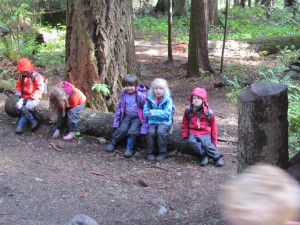Envisioning a Nature Kindergarten

Originally appears in the Summer 2014 issue
THE NATURE KINDERGARTEN BEGAN as a dream of two educators. A local school principal was inspired by her son’s experience in a Waldkindergarten in Germany, and became interested in creating a similar experience for young children in the Sooke School District
on Vancouver Island in British Columbia. Northern European countries have been offering outdoor early childhood programs
for over thirty years based on the belief that children benefit from being outside in whatever the weather in the natural world around them. As a researcher in the field of early childhood education, I was similarly interested in developing a program where children could learn and grow outdoors. With a shared vision, we met and began to plan this nature kindergarten. As this was a new idea to British Columbia schools, we first invited others who could enrich our vision and asked if they would serve on an advisory committee. First, we gained the support of the superintendent and school trustees. Then we asked representatives of local universities and a community college to join the committee.
Eventually, local parks and recreation planners, naturalists, a wilderness first aid instructor and museum staff became involved. As members of the advisory committee shared their perspectives and expertise, our vision became more firmly local.
After much planning, the school district committed to developing a nature kindergarten as a pilot program. The goal was to explore the possibilities of children spending every morning outside in a natural setting, and coming back to school for the afternoon for play-based learning indoors. The pilot would meet the needs of the prescribed learning outcomes for British Columbia. Sangster Elementary School was chosen as the location because of its easy access to oldgrowth forests, as well as the Esquimalt Lagoon – home to herons, swans and ducks, and a beach across the street, facing the Strait of Juan de Fuca.
We hoped that as the children explored their local, natural environment, they would develop confidence about being outside, and come to know their home in a rich and satisfying way. By learning together, we believed that they would develop into a community with strong investigation and collaboration skills. In the outdoors, large and noisy movements are accepted. As Early Childhood Education professor Mary Rivkin says, “not only is there typically more space out-of-doors, there is less in that space to bump into, break, or lose parts of. One’s body is no longer under need of tight control – its capabilities to shout, sing, leap, roll, stretch and fling are unleashed.” The focus on physical activity all morning would facilitate children’s balance, stamina and strength. Children would grow confidence in their abilities to name plants, climb trees, or walk the last part of the trail in wet boots, and be able to bring this confidence into other areas of their life
To view the photo-rich magazine version, click here.
If you are not already a subscriber, please subscribe to read the full article
Enid Elliot is an early childhood educator and member of the faculty at Camosun College, in Victoria, British Columbia and an adjunct professor at University of Victoria.
Leave a Reply
You must be logged in to post a comment.





